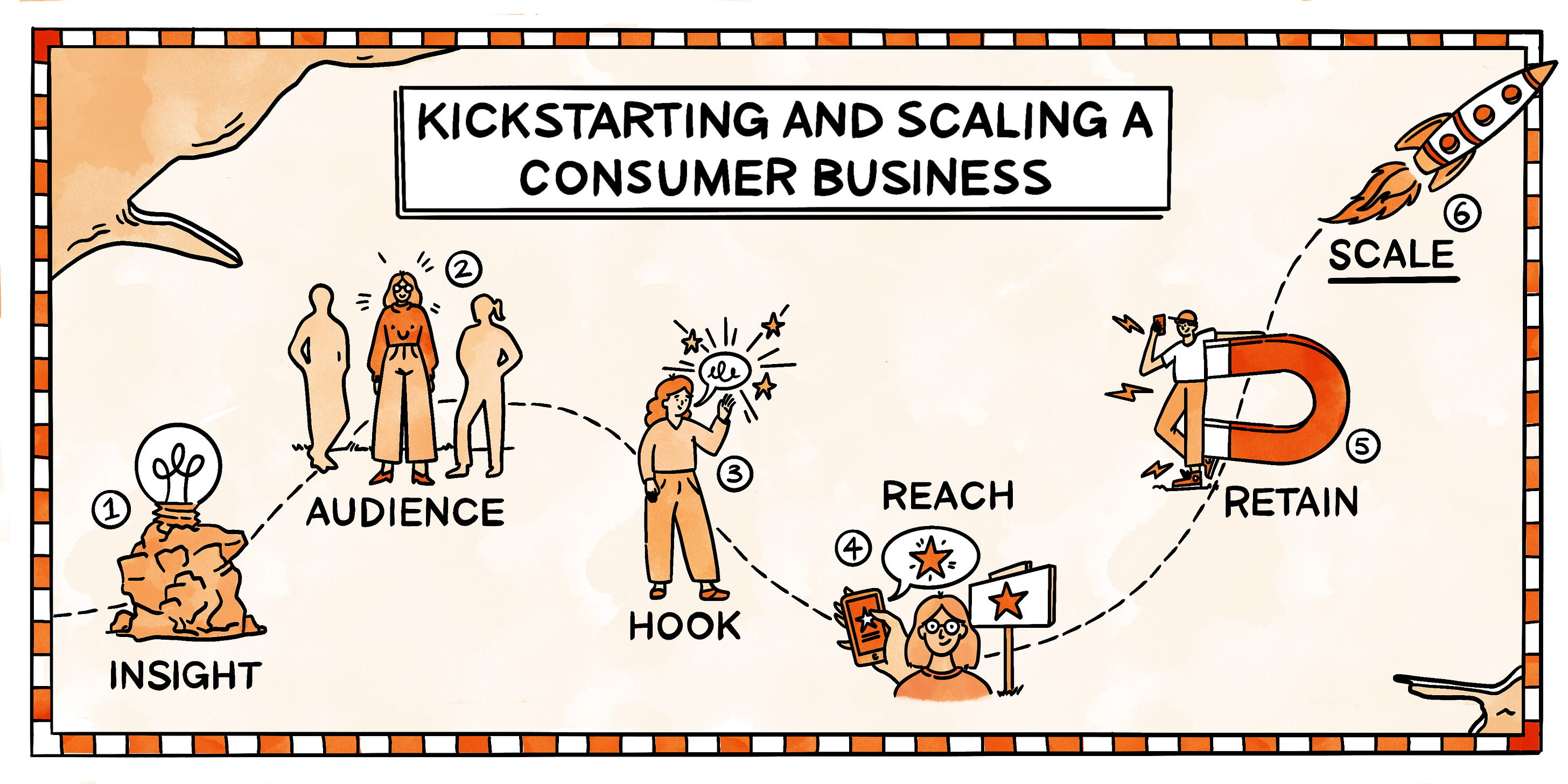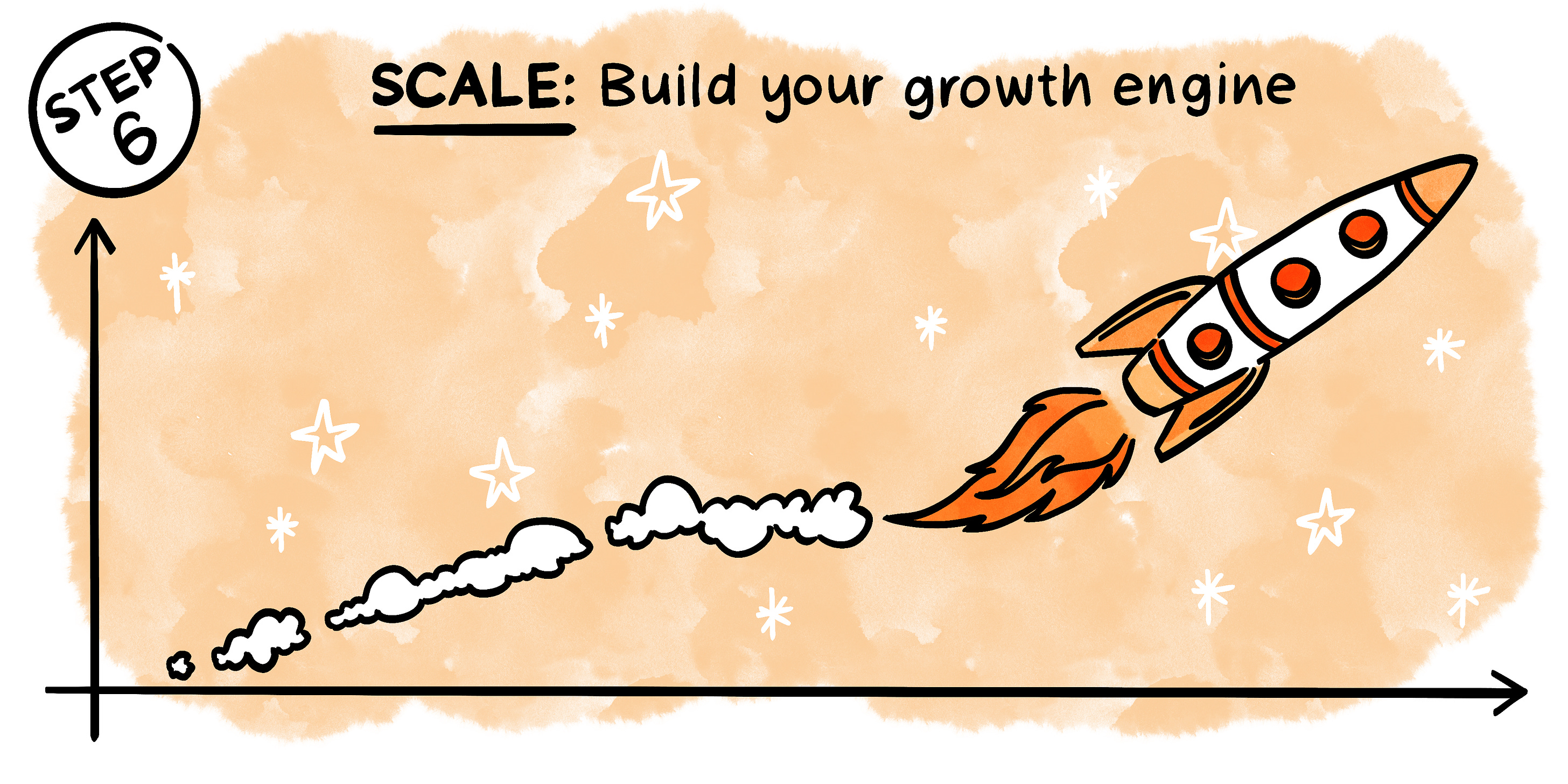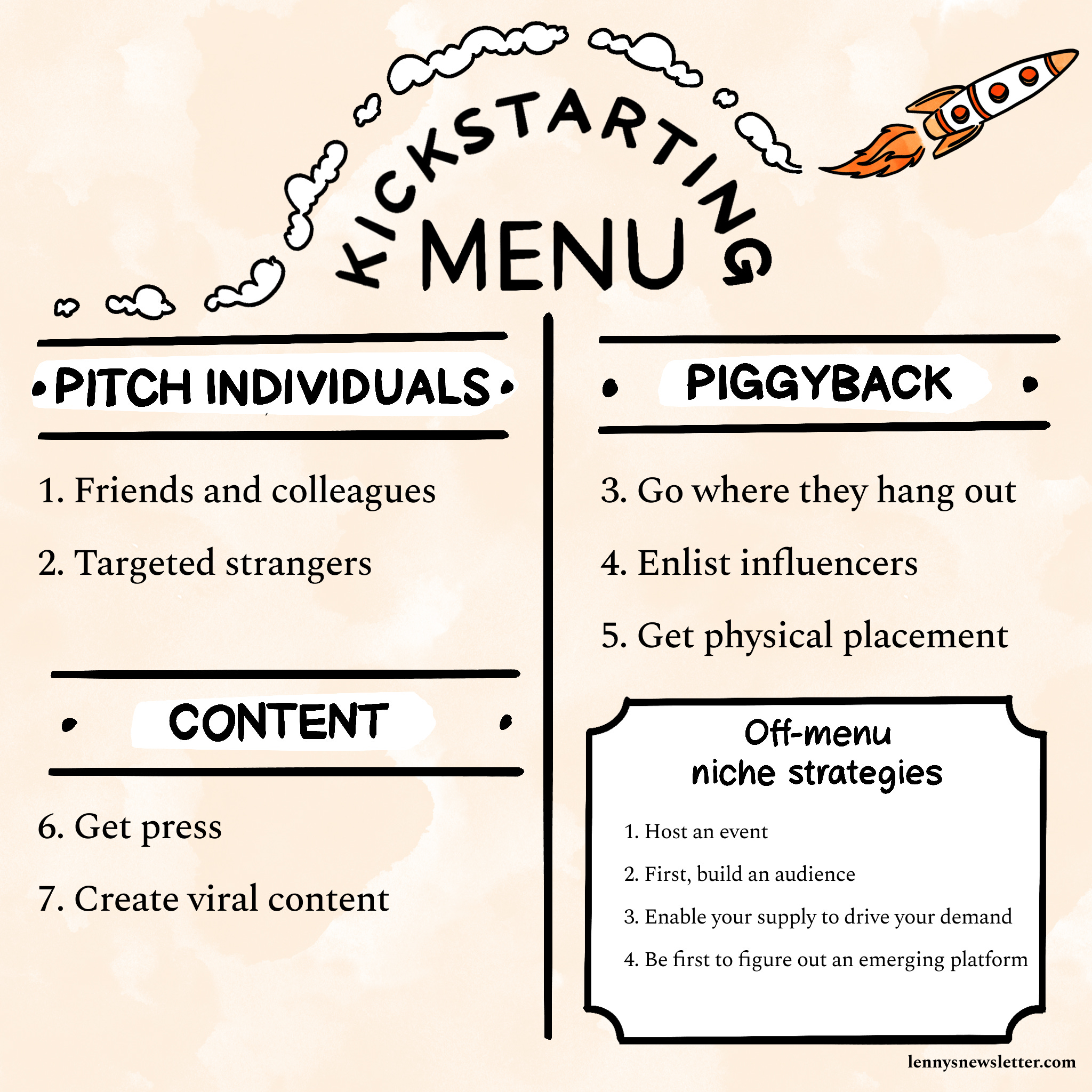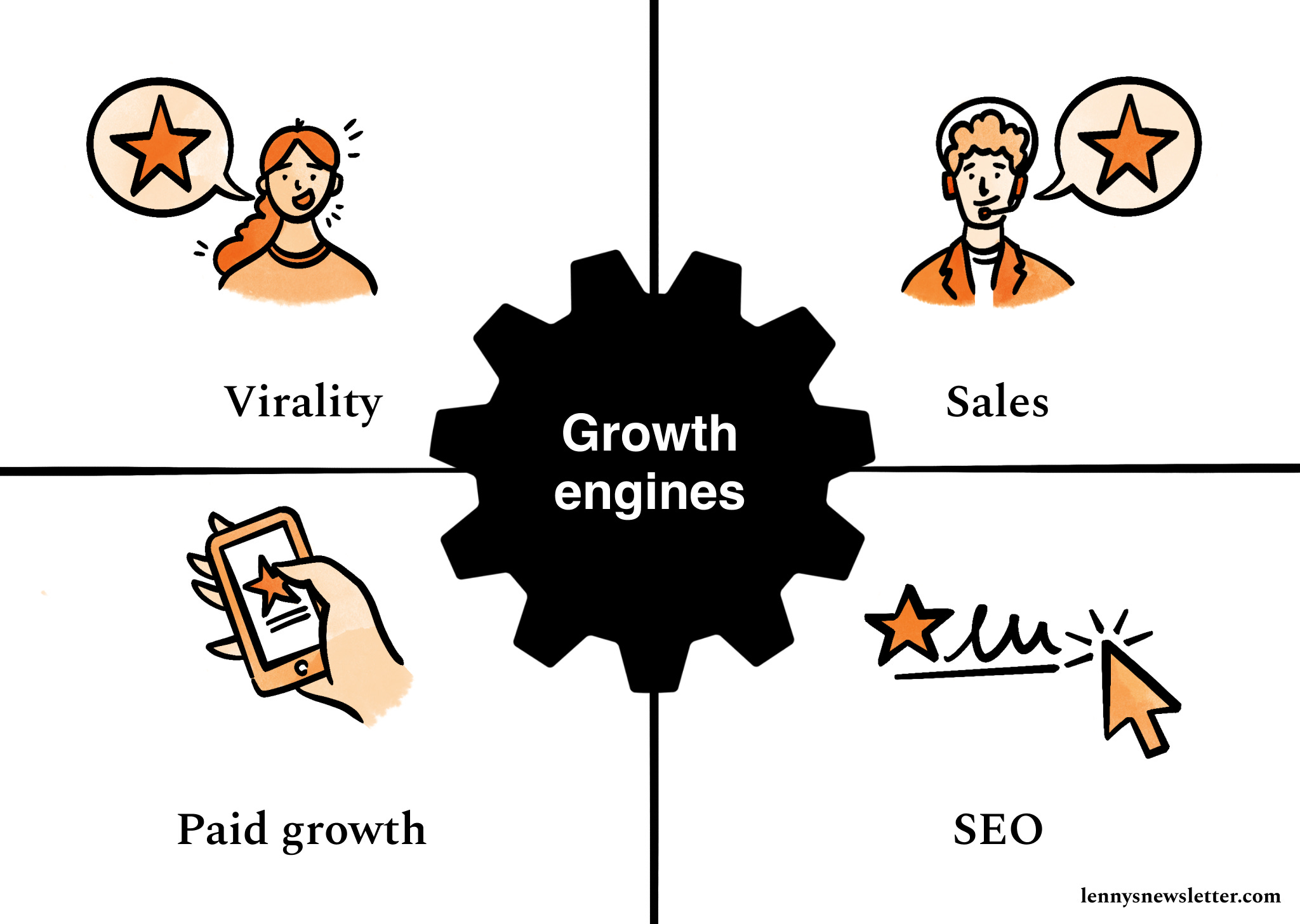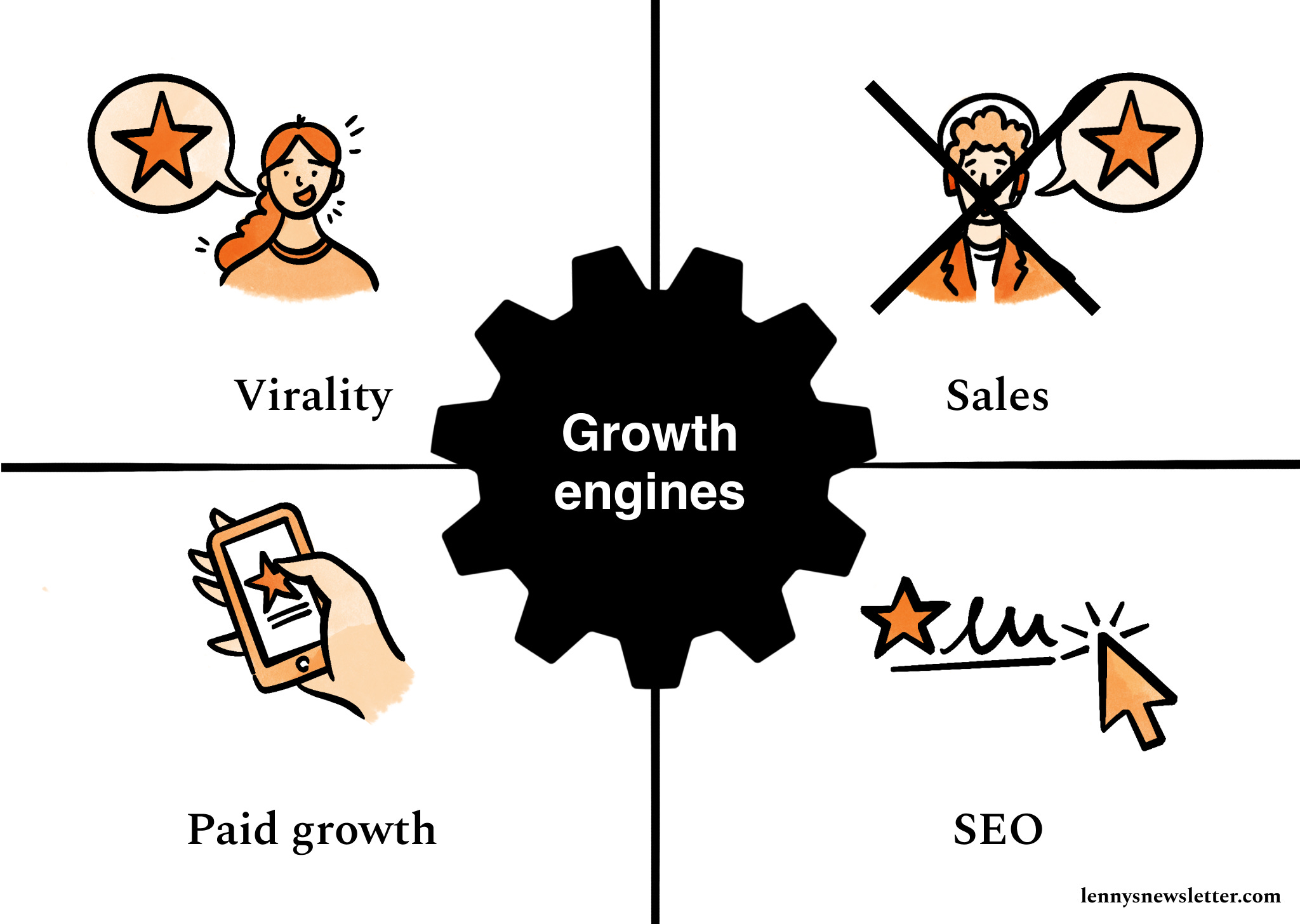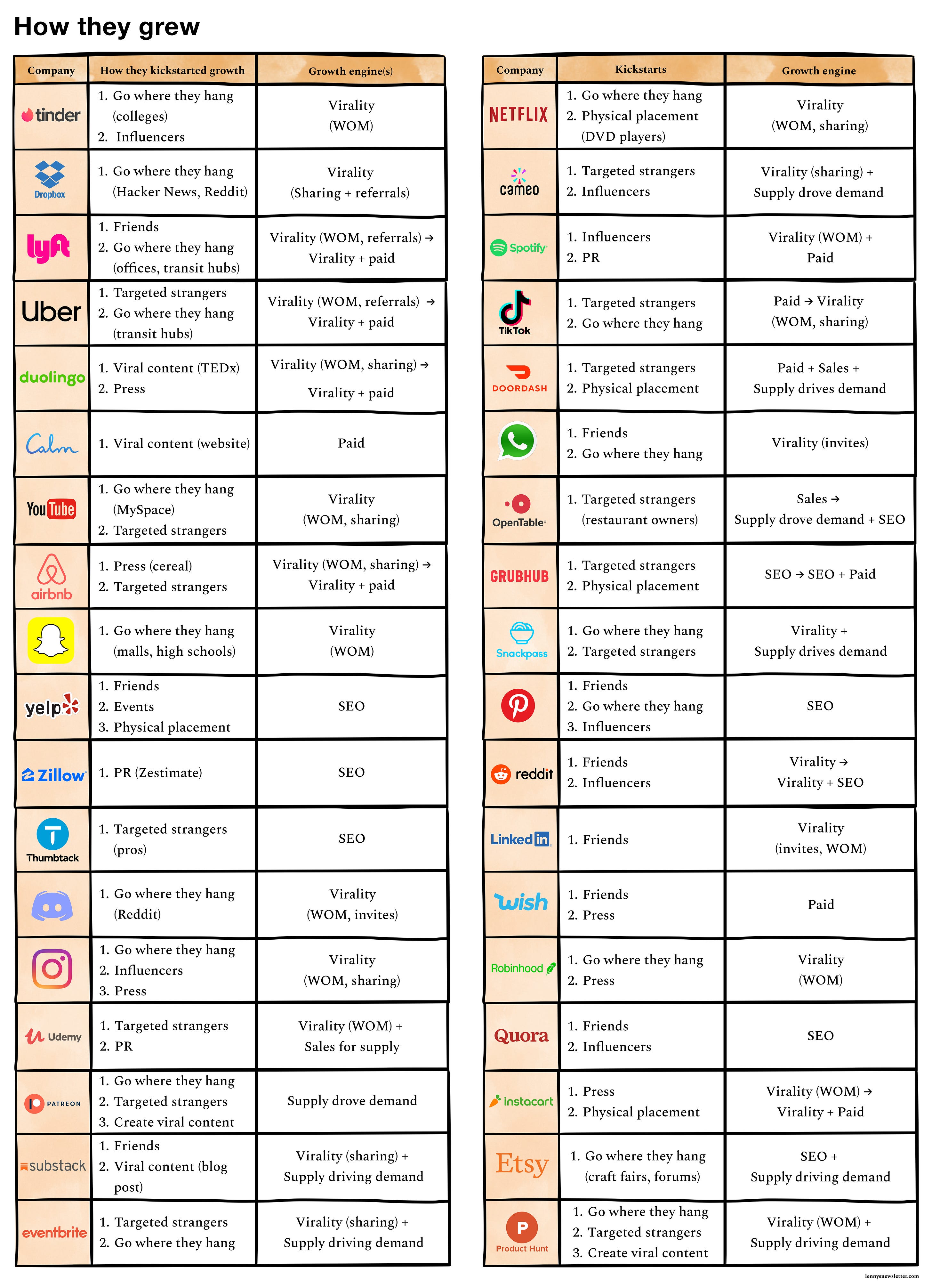Kickstarting and scaling a consumer business—Step 6: SCALE: Build your growth engine
Below is a peek at today’s subscriber-only post, part six of my six-part series on kickstarting and scaling a consumer marketplace. Subscribe today and get access to this issue—and every issue. Kickstarting and scaling a consumer business—Step 6: SCALE: Build your growth engineHow products grow, how your product will grow, and the GTM motions of today’s biggest consumer apps👋 Hey, I’m Lenny and welcome to a 🔒 subscriber-only edition 🔒 of my weekly newsletter. Each week I tackle reader questions about product, growth, working with humans, and anything else that’s stressing you out about work. Send me your questions and in return I’ll humbly offer actionable real-talk advice. If you know someone who would benefit from this, feel free to forward it along. Welcome to part six (!!!) of our six-part series on kickstarting and scaling a consumer business. Here’s a recap of our journey so far:
By this point, you have a startup idea, a product, some early users, and hopefully a glimmer of product-market fit. Even if you don’t have any of these, you should still be thinking about how your product will grow as you scale. How you grow will impact what you build, and what you build will impact how you grow. In this post, we’ll look at:
Let’s get those growth engines roaring. A big thank-you to Adam Fishman (Lyft, Patreon), Casey Winters (Grubhub), Cem Kansu (Duolingo), Gagan Biyani (Udemy), Jonathan Badeen (Tinder), Kevin Tan (Snackpass), Max Mullen (Instacart), Mike Evans (Fixer), Nickey Skarstad (Etsy), Scott Belsky (Behance), Sriram Krishnan (Calm), and Tamara Mendelsohn (Eventbrite) for contributing to this post, and Natalie for illustrations 🙏
Growth used to be a mysterious dark art. Fortunately, as you’ve seen in this series, and as you’ll see below, it’s becoming much less so. There are shockingly few paths to lasting sustainable growth, and there’s a growing fountain of knowledge to help you understand each path. In this post, as we transition from doing things that don’t scale to scaling the things that you’re doing, we’ll explore how products grow, how your product is likely to grow, and how today’s biggest consumer businesses kickstarted and scaled growth. Let’s get into it. How products growWhen you’re just starting out, as we saw in step four of our series, there are only seven reliable ways to kickstart your growth (i.e. get your first 1,000 users): To scale your growth, your options are even more limited. There are only four sources of self-sustaining long-term growth, aka growth engines: For consumer startups, it’s actually even simpler. There are only three feasible growth engines (since relying on sales is rarely economical): Why so few ways to grow? Think about it. How many ways do you find out about most new products? Either you see an advertisement (i.e. paid growth), you find it while searching online (i.e. SEO), someone reaches out and pitches you on it (i.e. sales), or a friend tells you about it and/or you see it shared on social media (i.e. virality). Even more interestingly, the majority of startups grow primarily through just one of these engines. For example, nearly 100% of Tinder’s growth came through word of mouth (WOM), Calm’s through paid growth, and Thumbtack’s through SEO. This is true for nearly every startup out there, especially at first. A common pitfall of early-stage startups is trying to invest in too many engines at once and not nail any. At scale, in order to win a market, you have to become world-class at your primary growth engine. To quote Dan Hockenmaier and myself from a post on this topic:
Over time, most companies layer on an additional engine (usually paid growth, sometimes SEO) in order to continue to grow while their initial growth engine plateaus (learn about S-curves and adding layers to your cake). But timing those investments correctly is critical, and that initial engine normally continues to drive the majority of your growth. Note, even though there are a limited set of strategies, there are infinite ways to be creative about how you execute each of them, e.g. Netflix infiltrating DVD forums, Hipcamp setting up tables outside REIs, Airbnb selling cereal. Your job as a founder looking to grow your product is to (1) creatively execute two to three kickstarting tactics and (2) become world-class at one primary growth engine. That’s essentially your high-level GTM strategy. Here’s a link to the worksheet we’ve been using throughout this series to help you plan your GTM. GTM motions of today’s biggest consumer appsTo bring it all together, here’s an overview of how today’s biggest consumer businesses kickstart their growth, and their primary growth engine. A few stories I’ve gathered from founders and early employees describing their primary growth engines: 1. Virality (which can be driven by word of mouth, sharing content, sending invites to your friends, or a referral program)Airbnb (WOM, referrals):
Instacart (WOM, referrals):
Udemy (WOM):
Behance (WOM, sharing content):
Instagram (WOM, sharing content):
LinkedIn (inviting friends):
Pinduoduo (inviting friends):
2. SEOThumbtack:
Yelp:
Etsy:
Zillow:
Grubhub:
3. PaidBooking.com:
Uber:
Two bonus growth engines just for marketplaces and platforms: Sales, and Supply driving demandSalesAs I noted above, sales is rarely an effective growth engine for B2C startups—with the exception of marketplaces and platforms, where the supply is incredibly valuable. In those cases, sales is both an important kickstarting tactic and an important part of the overall growth strategy. Grubhub:
Udemy:
OpenTable:
Etsy:
Caviar:
Supply driving demandYou’ll notice in the table above there’s an additional growth engine, “Supply drives demand,” that again exists only for marketplaces and platform startups. How this works is within a marketplace, your supply (e.g. DoorDash restaurants, Substack writers, Eventbrite event organizers) often drive their customers/audience to your site because it benefits them (e.g. restaurants tell customers to order from DoorDash, writers drive people to Substack to subscribe, event organizers send everyone their Eventbrite ticketing page). Although technically this is a growth engine, and an incredibly powerful one, it won’t be the source of your growth because you still need to grow the supply in the first place (usually through sales), and there isn’t a ton you can do to accelerate this engine. But when you do have this engine in place, lean into it big-time because it creates an incredible unfair advantage. A few examples of this engine in action: DoorDash:
Etsy:
Eventbrite:
Snackpass:
Learn more about kickstarting and scaling your marketplace here. How your product will likely growI suspect a question you’ve had on your mind this whole time is which of the three growth engines is likely right for you. You’re probably also wondering, “Ooo, how do I grow through virality? That sounds great!” Unfortunately, that’s not how it works. Your product needs to be a fit with the growth engine, and it’ll only work out if it’s a natural fit. Below is a handy guide that’ll tell you which growth engine is likely the best fit. Though it may not be what you want, you’re lucky if you can get even one to work at meaningful scale. What you’re looking for is an unfair advantage that allows you to become world-class at that growth engine. You’ll likely grow primarily through SEO if:
Subscribe to Lenny's Newsletter to read the rest.Become a paying subscriber of Lenny's Newsletter to get access to this postand other subscriber-only content. A subscription gets you:
|
Older messages
The rituals of great teams | Shishir Mehrotra, Coda, YouTube, Microsoft
Sunday, August 14, 2022
Listen now (92 min) | Shishir Mehrotra is the co-founder and CEO of Coda, and formerly head of product and engineering at YouTube. In this episode, he shares his insights on growth strategy, how he
How to kickstart and scale a consumer business—Step 5: RETAIN: Iterate until enough people stick around
Tuesday, August 9, 2022
How to know if you've got product-market fit, how to iterate toward product-market fit, and how long it usually takes
Sign in to Lenny's Newsletter
Tuesday, August 9, 2022
. Here's a link to sign in to Lenny's Newsletter. This link can only be used once and expires after 24 hours. If expired, please try logging in again here Sign in now © 2022 2443 Fillmore St.,
How to launch and grow your product | Ryan Hoover of Product Hunt and Weekend Fund
Sunday, August 7, 2022
Listen now | Thousands of new products launch each year, but very few make it. Ryan Hoover has seen thousands of products launched over the course of his time running Product Hunt, and in this episode,
How to kickstart and scale a consumer business—Step 4: Find your early adopters by doing things that don’t scale
Tuesday, July 26, 2022
Also, how today's biggest consumer products got their first 1000 users
You Might Also Like
🚀 Ready to scale? Apply now for the TinySeed SaaS Accelerator
Friday, February 14, 2025
What could $120K+ in funding do for your business?
📂 How to find a technical cofounder
Friday, February 14, 2025
If you're a marketer looking to become a founder, this newsletter is for you. Starting a startup alone is hard. Very hard. Even as someone who learned to code, I still believe that the
AI Impact Curves
Friday, February 14, 2025
Tomasz Tunguz Venture Capitalist If you were forwarded this newsletter, and you'd like to receive it in the future, subscribe here. AI Impact Curves What is the impact of AI across different
15 Silicon Valley Startups Raised $302 Million - Week of February 10, 2025
Friday, February 14, 2025
💕 AI's Power Couple 💰 How Stablecoins Could Drive the Dollar 🚚 USPS Halts China Inbound Packages for 12 Hours 💲 No One Knows How to Price AI Tools 💰 Blackrock & G42 on Financing AI
The Rewrite and Hybrid Favoritism 🤫
Friday, February 14, 2025
Dogs, Yay. Humans, Nay͏ ͏ ͏ ͏ ͏ ͏ ͏ ͏ ͏ ͏ ͏ ͏ ͏ ͏ ͏ ͏ ͏ ͏ ͏ ͏ ͏ ͏ ͏ ͏ ͏ ͏ ͏ ͏ ͏ ͏ ͏ ͏ ͏ ͏ ͏ ͏ ͏ ͏ ͏ ͏ ͏ ͏ ͏ ͏ ͏ ͏ ͏ ͏ ͏ ͏ ͏ ͏ ͏ ͏ ͏ ͏ ͏ ͏ ͏ ͏
🦄 AI product creation marketplace
Friday, February 14, 2025
Arcade is an AI-powered platform and marketplace that lets you design and create custom products, like jewelry.
Crazy week
Friday, February 14, 2025
Crazy week. ͏ ͏ ͏ ͏ ͏ ͏ ͏ ͏ ͏ ͏ ͏ ͏ ͏ ͏ ͏ ͏ ͏ ͏ ͏ ͏ ͏ ͏ ͏ ͏ ͏ ͏ ͏ ͏ ͏ ͏ ͏ ͏ ͏ ͏ ͏ ͏ ͏ ͏ ͏ ͏ ͏ ͏ ͏ ͏ ͏ ͏ ͏ ͏ ͏ ͏ ͏ ͏ ͏ ͏ ͏ ͏ ͏ ͏ ͏ ͏ ͏ ͏ ͏ ͏ ͏ ͏ ͏ ͏ ͏ ͏ ͏ ͏ ͏ ͏ ͏ ͏ ͏ ͏ ͏ ͏ ͏ ͏ ͏ ͏ ͏ ͏ ͏ ͏ ͏ ͏ ͏ ͏ ͏ ͏ ͏
join me: 6 trends shaping the AI landscape in 2025
Friday, February 14, 2025
this is tomorrow Hi there, Isabelle here, Senior Editor & Analyst at CB Insights. Tomorrow, I'll be breaking down the biggest shifts in AI – from the M&A surge to the deals fueling the
Six Startups to Watch
Friday, February 14, 2025
AI wrappers, DNA sequencing, fintech super-apps, and more. ͏ ͏ ͏ ͏ ͏ ͏ ͏ ͏ ͏ ͏ ͏ ͏ ͏ ͏ ͏ ͏ ͏ ͏ ͏ ͏ ͏ ͏ ͏ ͏ ͏ ͏ ͏ ͏ ͏ ͏ ͏ ͏ ͏ ͏ ͏ ͏ ͏ ͏ ͏ ͏ ͏ ͏ ͏ ͏ ͏ ͏ ͏ ͏ ͏ ͏ ͏ ͏ ͏ ͏ ͏ ͏ ͏ ͏ ͏ ͏ ͏ ͏ ͏ ͏ ͏ ͏ ͏ ͏ ͏ ͏ ͏
How Will AI-Native Games Work? Well, Now We Know.
Friday, February 14, 2025
A Deep Dive Into Simcluster ͏ ͏ ͏ ͏ ͏ ͏ ͏ ͏ ͏ ͏ ͏ ͏ ͏ ͏ ͏ ͏ ͏ ͏ ͏ ͏ ͏ ͏ ͏ ͏ ͏ ͏ ͏ ͏ ͏ ͏ ͏ ͏ ͏ ͏ ͏ ͏ ͏ ͏ ͏ ͏ ͏ ͏ ͏ ͏ ͏ ͏ ͏ ͏ ͏ ͏ ͏ ͏ ͏ ͏ ͏ ͏ ͏ ͏ ͏ ͏ ͏ ͏ ͏ ͏ ͏ ͏ ͏ ͏ ͏ ͏ ͏ ͏ ͏ ͏ ͏ ͏ ͏ ͏ ͏ ͏ ͏ ͏ ͏ ͏ ͏ ͏ ͏

